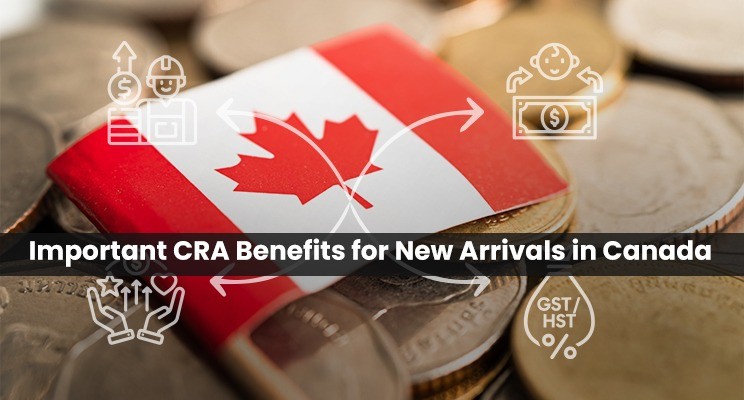
Canada is renowned for its strong social safety net, which includes a range of financial benefits managed by the Canada Revenue Agency (CRA). For newcomers, understanding these benefits is crucial for establishing financial security and integrating smoothly into Canadian society. Here’s a comprehensive guide to the key monetary CRA benefits available to newcomers.
Understanding the CRA
The Canada Revenue Agency (CRA) administers tax laws for the federal government and most provinces and territories. It also oversees various social and economic benefits and incentive programs delivered through the tax system. For newcomers, the CRA is a vital point of contact to access financial benefits that ease the transition to Canadian life.
Who is Considered a Newcomer?
The CRA defines a newcomer as an individual or family who becomes a resident of Canada for the first time. This includes permanent residents, refugees (protected persons), and temporary residents such as workers, students, or temporary resident permit holders.
Key Monetary CRA Benefits for Newcomers
1. Canada Child Benefit (CCB)
The CCB is a tax-free monthly payment designed to help families with children under 18 years of age. It significantly reduces the financial burden for newcomers with children.
Eligibility:
- The child must be under 18 years old.
- You or your spouse/common-law partner must be a Canadian citizen, permanent resident, protected person, or a temporary resident who has lived in Canada for the previous 18 months and has a valid permit in the 19th month.
- You must reside in Canada.
Application Process:
- Complete the RC66 form and provide documentation of your immigration status.
- Submit the application online through My CRA Account, by mail, or using a licensed service provider.
Benefit Amount:
- The amount received depends on your household net income and the number of children.
- As of now, the maximum yearly payment is $7,437 per year ($619.75 per month) for each child under six and $7,437 per year ($619.75 per month) for each child six to seventeen if your AFNI is under $34,863 annually.
- Payments are made on the 20th of each month.
2. GST/HST Credit
The GST/HST credit is a tax-free quarterly payment that helps individuals and families with low and modest incomes offset some of the GST or HST they pay.
Eligibility:
- Must be a resident of Canada for income tax purposes and meet one of the following:
- 19 years or older.
- Have (or had) a spouse or common-law partner.
- Are (or were) a parent and live (or lived) with your child.
Application Process:
- Fill out the RC151 form (GST/HST Credit Application for Individuals Who Become Residents of Canada).
Benefit Amount:
- The amount depends on your marital status and family net income.
- A couple with two children might receive up to $992 quarterly, while a single person without children could get up to $496 from July 2023 to June 2024.
- Payments are made on the 5th day of July, October, January, and April.
3. Canada Workers Benefit (CWB)
The CWB is a refundable tax credit aimed at supplementing the earnings of low-income workers to encourage employment.
Eligibility:
- You are a resident of Canada throughout the year.
- You are 19 or older on December 31, or live with your spouse, common-law partner, or child.
For the ongoing payment schedule, you are eligible for CWB if you are currently working and your net income is less than the income mentioned below:

Application Process:
- No separate application is needed. The CRA determines your eligibility when you file your income tax and benefit return.
Benefit Amount:
- A single individual can receive up to $1,428 annually if their adjusted annual net income is $23,495 or less.
- A family can get up to $2,461 annually if their annual net income is $26,805 or less.
- Payments are made quarterly on the 15th of each month.
4. Provincial Benefits
In addition to federal benefits, each province and territory offers programs to support residents. These can include additional benefits for children, health benefits, and housing assistance.
Common Provincial Benefits:
Ontario Trillium Benefit (OTB):
Combines the Ontario Sales Tax Credit, Ontario Energy and Property Tax Credit, and Northern Ontario Energy Credit.
- Alberta Child and Family Benefit (ACFB): Provides financial assistance to lower-income families with children.
- B.C. Family Benefits: Includes the Affordable Child Care Benefit and the BC Child Opportunity Benefit.
Tips to Maximize Your Gains
Navigating the various benefits can be challenging, but these tips can help:
- Submit Your Tax Return: Filing an annual tax return is necessary to access most CRA services.
- Obtain Your Social Insurance Number (SIN): This is essential for working in Canada and accessing government services and perks.
- Keep Your Information Updated: Ensure the CRA has your current address and banking details to avoid benefit delays.
- Get Expert Assistance: Use settlement services for newcomers or a qualified tax expert if you need help with your tax return or benefits applications.
- Stay Updated: Government benefits and policies may change. Regularly visit the CRA website or sign up for CRA alerts.
Caution Against Tax Scams
Be wary of tax frauds and scams, especially those targeting newcomers. The CRA will never request personal information such as your SIN, credit card number, or bank account number through aggressive language or threats. They will also not ask for fees via prepaid credit cards or gift cards.
By understanding and accessing these benefits, newcomers to Canada can ensure financial stability and a smoother transition into their new lives. Welcome to Canada, and here’s to a bright and prosperous future!